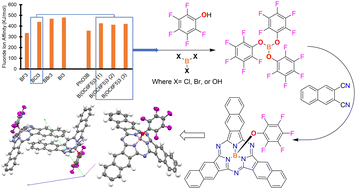Triphenyl borates used to avoid the bay-position halogenation of boron subnaphthalocyanines; and for the subnaphthalocyanine, subphthalocyanine and hybrids formation†
Abstract
We demonstrate herein a reported syntheses pathway for form unsubstituted boron subnaphthalocyanines (BsubNcs) since their discovery in 1995 and to avoid random bay-position halogenation. This was achieved through the use of triphenyl borates as the macrocyclic templating reagent avoiding the formation of random bay-position halogenated BsubNc by-products. We also outline a method to screen boron templating reagents by computing their Lewis acidity using the fluoride ion affinity method as well as the screening of the macrocyclic precursor by determining its Lewis basicity using a boron trifluoride affinity scale of various organic macrocyclic precursors in order to balance these parameters to enable macrocycle formation. We find that a balancing of these parameters enabled multiple methods for the synthesis of unsubstituted BsubNc. For this study, we isolated the axially fluorinated and axially pentafluorophenoxylated BsubNcs and characterize their photophysical and electrochemical properties as there was no random bay-position substitutions. For this study, we also demonstrated as a ‘part 2’ the versatility in the synthetic methods developed through the synthesis of boron subphthalocyanines (BsubPcs), other BsubNcs and a hybrid materials of BsubPc + BsubNc called Bsub(Pc3-p + Ncp). We also explored an industrially relevant synthesis method of triphenyl borates and found it to be successful in the processes outlined herein providing a potential route to improving the sustainability of this class of triphenyl borate materials.

- This article is part of the themed collection: New Journal of Chemistry HOT Articles


 Please wait while we load your content...
Please wait while we load your content...